Michigan chestnut update – June 12, 2013
Rose chafer activity has begun as far north as west central Michigan.
So far this season, the East Lansing Enviro-weather station has accumulated 610 GDD50 with 0.85 inches of rain over the past week; the Clarksville Enviro-weather station has recorded 558 GDD50 with 0.42 inches of rain the past week; and the Northwest Michigan Horticultural Research Center accumulated 457 GDD50 with 0.09 inches of rain over the last week.
With pollination likely to be taking place in late June and early July, depending on variety and location, it is interesting to reflect on trends observed in previous seasons. Cold and rainy weather has proven to be non-conducive to pollination and yields in the past, with poor conditions in 2009 estimated to reduce yields by 60 percent in Michigan. Rain reduces pollination by washing the windborne pollen out of the air before it can reach receptive flowers. Cold weather slows the growth of the pollen tube and decreases the likelihood of fertilization while the ovary is still viable.
After we get through pollination, the estimation of the crop begins as burrs forms. Growers should remember that some burrs will not produce nuts, so be sure to take a look inside for a more accurate gauge of pollination success. In late August, growers can cut open some burs and check to ensure the nuts are developing. Ideally, we will see temperatures in high 70s and 80s between mid-June and mid-July and not a lot of rain for optimal pollination.
Potato leafhoppers were caught for the second week in a row, still at relatively low levels with just three to four per trap; no nymphs were observed. Growers should continue to monitor for potato leafhoppers to determine population level and treatment efficacy. Growers can hang yellow sticky traps in orchards to continue to monitor for this pest.
Like many plants, chestnuts are sensitive to the saliva of potato leafhoppers which is injected by the insect while feeding. Damage to leaf tissue can cause reduced photosynthesis that can impact production and quality, and damage the tree. Most injury occurs on new tissue on shoot terminals with potato leafhoppers feeding near the edges of the leaves using piercing-sucking mouthparts. Symptoms of feeding appear as whitish dots arranged in triangular shapes near the edges. Heavily damaged leaves are cupped with necrotic and chlorotic edges and eventually abscise from the tree. Severely infested shoots produce small, bunched leaves with reduced photosynthetic capacity.
Adult leafhoppers are pale to bright green and about 1/8 inch long. Adults are easily noticeable, jumping, flying or running when agitated. The nymphs (immature leafhoppers) are pale green and have no wings, but are very similar in form to the adults. Potato leafhoppers move in all directions when disturbed, unlike some leafhoppers that have a distinct pattern of movement.
The potato leafhopper can’t survive Michigan’s winter and survives in the Gulf States until adults migrate north in the spring on storm systems. Yellow sticky traps are recommended to determine when the first potato leafhoppers arrive. Growers should also walk through their orchards, flipping over leaves and looking for adult potato leafhoppers.
The most common classes of insecticides recommended for control of potato leafhoppers include the pyrethroids, carbamates, neonicotinoids and organophosphates. See the additional Michigan State University Extension article, “Potato leafhopper management in chestnuts” for more information. Remember, even growers who believe they may have experienced crop losses due to the frost and freeze events this spring will still need to treat for potato leafhoppers to maintain tree health.
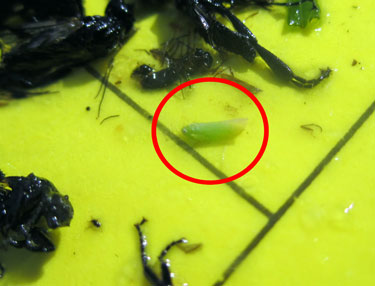
Potato leafhopper on yellow sticky trap.
Photo credit: Erin Lizotte, MSU Extension
Feeding damage from overwintering obliquebanded leafroller larvae has subsided this week and based on the large size of the larvae last week, obliquebanded leafroller larvae are likely pupating and will emerge as adult moths in the coming weeks. Some feeding damage to foliage can be tolerated in chestnuts, but larvae can feed on bud tissue, so scouting for this pest is important.
Obliquebanded leafroller larvae roll leaves and create a tubular chamber where they remain except when feeding. Mature larvae are around 1 inch in length, have a flattened, black head capsule and yellowish-green bodies. Adults emerge and mate, laying eggs for a second generation of larvae that typically peaks in July. Wings of the adult are banded with tan to brown scales and can often be seen gathering on the sides of buildings with outdoor lighting after sunset.
Growers can purchase pheromone lures for use in delta traps to capture adult obliquebanded leafrollers. Trapping adults is a good indication of presence and potentially gives a sense of population levels, but because this insect overwinters as larvae, adults will be captured only after the initial damage from overwintering larvae is done, making the visual scouting important. Additionally, growers only trapping adults will miss the first larval treatment window, which may be important if high populations occur.
Pyrethroids and spinosyn-based insecticides are the standard classes used to target the larval phase of this insect (refer to the chestnut pesticides table for more information on labeled products). Growers should not spray for obliquebanded leafrollers unless they have confirmed the presence of this pest at a damaging level and are sure that larval stage is present. Based on what we are seeing now, the first window for treatment has passed as larvae are no longer feeding.
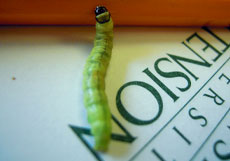
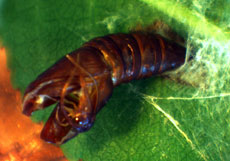
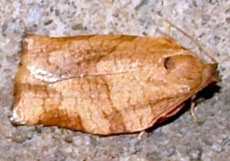
Left, An obliquebanded leafroller larva close to maturity. Photo credit: Erin Lizotte, MSU Extension. Middle, The
empty pupal casing left from an obliquebanded leafroller. Photo credit: Erin Lizotte, MSU Extension. Right, An adult
obliquebanded leafroller. Photo credit: Cheryl Moorehead, Bugwood.org.
Rose chafers have been spotted as far north as west central Michigan and will likely arrive in northwest Michigan any day. Rose chafers are considered a generalist pest and affect many crops, particularly those found on or near sandy soils or grassy areas. The adult beetles feed heavily on foliage and blossom parts of numerous horticultural crops in Michigan and can cause significant damage to chestnut orchards. Rose chafers can be particularly damaging on young trees with limited leaf area. Like Japanese beetles, rose chafer skeletonize chestnut leaves, but tend to consume larger pockets of tissue with damage similar to caterpillar feeding than the fine, lace-like leaf that results from Japanese beetle feeding.
Rose chafers are light tan with a darker brown head, long legs and are about 12 millimeters long. There is one generation per year. Adults emerge from the ground during late May or June and live for three to four weeks. They are often found in mating pairs and fly during daylight hours. Visual observation while walking a transect is the best method for locating them. Because of their aggregating behavior, they tend to be found in larger groups and are typically relatively easy to spot.
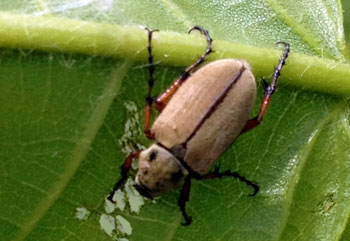

Left, Rose chafer on chestnut. Photo credit: Mario Mandujano, MSU Extension. Right, Typical feeding damage from
rose chafers on chestnut. Photo credit: Erin Lizotte, MSU Extension.
There are no established treatment thresholds or data on how much damage a healthy chestnut tree can sustain from rose chafers, but growers should consider that well-established and vigorous orchards will likely not require complete control. Younger orchards with limited leaf area will need to be managed more aggressively.
Managing rose chafers can be a frustrating endeavor as they can re-infest from surrounding areas quickly. This re-infestation is often misinterpreted as an insecticide failure, but efficacy trials have shown that a number of insecticides remain effective treatment options. Carbamate, organophosphate, pyrethroid and neonicotinoid insecticides all have good activity against rose chafers and can provide some control.
Organic options including azadirachtin products and surround are marginally effective. Growers choosing to use kaolin clay should remember that good coverage is key and those considering pyrethroids or neonicotinoids should be aware that these products may potentially increase pest mite populations. Refer to the article “Rose chafer management in chestnuts for 2013“ for more information on rose chafer biology and management.
Dr. Fulbright's work is funded in part by MSU's AgBioResearch.



 Print
Print Email
Email

